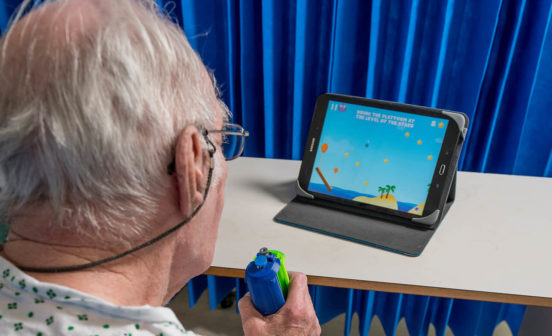Innovation Cognitive-boosting electrical stimulation is influenced by brain connectivity

Individuals with stronger brain connectivity benefit from a cognitive boost when receiving brain stimulation, according to a new study.
Applying a non-invasive method of electrical stimulation to a region of the brain important for cognition has previously been shown to improve cognitive performance for some people. Researchers in the Brain Sciences Theme of the NIHR Imperial BRC have now uncovered why brain stimulation offers cognitive benefits to some people more than others. The key determinant is an individual’s white matter structure – the fibres that connect different parts of the brain.
The study published in the Journal NeuroImage and led by Dr Lucia Li and Professor David Sharp, focused on a key aspect of cognition known as cognitive control – the brain’s ability to make decisions based on our goals, rather than habits or reactions.
The team used a non-invasive method of brain stimulation called transcranial direct current stimulation (tDCS).
“Transcranial direct current stimulation uses constant, weak electrical current delivered via electrodes to stimulate specific parts of the brain – it’s entirely painless for the participant. Unlike cranial methods of brain stimulation, tDCS offers a way to determine which specific brain regions are involved when participants perform certain tasks,” explains Dr Li.
Numerous regions of the brain are connected together and constitute huge networks. The team used tDCS to study a large-scale brain network known as the Salience Network (SN) – consisting of areas of the brain previously known to be important for cognitive control.
It is possible to decode a person’s brain network by measuring functional MRI (fMRI) activity, which measures brain activity by detecting changes associated with blood flow. Study participants received stimulation while they were in an MRI scanner to observe how brain activity was affected by electrical stimulation.
Participants were then asked to undertake a ‘Stop Signal Task’, which requires them to respond as quickly and accurately as possible to an infrequent ‘stop’ signal appearing on a computer screen. This widely used task measures response inhibition – an important aspect of cognitive control.
Overall the majority of participants showed improved performance in the Stop Signal Task following brain stimulation. Interestingly the team discovered that this improvement in cognitive performance was dependent on white matter connectivity; participants with a high measure of brain connectivity improved their performance in the task, while those with low connectivity did not.
Dr Li, a clinical research fellow at TBI Group explains: “Only people with the strongest white matter connections between brain regions improved their cognitive performance with tDCS. Not only does this study confirm that cognitive function can be manipulated by tDCS, but it’s also important for understanding the reasons why brain stimulation only seems to work on some people.”
Discussing the potential clinical impact of this work, Dr Li says: “We have just completed a study where we applied this type of stimulation in patients with traumatic brain injury (TBI). Patients with TBI often have cognitive deficits, so we wanted to see whether this type of stimulation could also improve their cognitive performance. We are currently preparing this paper for publication.”
Whilst this study only investigated the effect of brain stimulation on a single brain region and one type of cognitive function, it sheds lights on a rapidly advancing area of neuroscience that may hold the key to future therapies. With many neurological and psychiatric disorder incurable, methods of brain stimulation such as tDCS may offer potential alternatives and advantages over current surgical and pharmaceutical approaches.
This story was written by Ellyw Evans and is copyright of Imperial College London.





